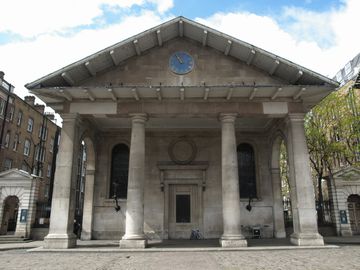

At 30 Bedford Street, we find the gates into St Paul's Churchyard. This charming hidden churchyard was built by the architect- the leading light of the English baroque, Inigo Jones. The gates to the churchyard are closed after dark, so if you've come in the evening, you'll have to miss this stop. In 1630 the local landowner, Lord Bedford, applied for permission to pull down slum houses on his land, and build a large piazza with expensive housing, to improve his earnings from the land. He planned 'housings and habitaciones fit for gentlemen and men of ability'. St Paul's Church was part of the plans, although – like many landowners – Bedford's only interest was in the financial side of things. He attempted to save money on the church, and told his architect, Inigo Jones, to make it as cheap as possible – 'slightly better than a barn'. 'My Lord, then you shall have the finest barn in England!', Jones replied. Although the church's magnificent portico looks onto the main Convent Garden piazza, there's no door there – the main entrance is here in this charming tree-line courtyard of peace and quiet. This church of St Paul shouldn't be confused with St Paul's Cathedral, in the City of London, of course. Since Covent Garden is London's 'theatre-land', it's no surprise that St Paul's is considered 'the actor's church'. The opening scene of 'My Fair Lady' has the flower-girl, Eliza Doolittle, selling her flowers in the church portico. The list of famous theatrical personalities buried here begins in the 19th century with W. S. Gilbert, the author behind the 'Gilbert and Sullivan' operettas; and goes on to include Charlie Chaplin, Gracie Fields, and Boris Karloff.